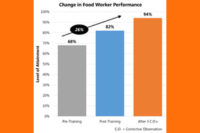FSMA Update: Staying ahead of the curve
Comments are in for proposed Produce Safety Rule and Preventive Controls, but final rules have not been issued, leaving processors time to explore audit and certification alternatives.

If you’re going through the motions of obtaining a GFSI certification (e.g., SQF, BRC, FSSC 22000), you may be in pretty good shape if FDA were to run an FSMA audit at your facility. Or, if you’re a farm-based producer following good agricultural practices, you may be set for an FDA visit. But whether you’re ready for FSMA may depend on the final rules developed from the input received during comment periods.
For example, foreign suppliers—especially importers—that have, by their own volition, had little to do with food safety in the past may find themselves ill-prepared to comply with FSMA, which means they will have to meet the same regulations as American processors. Producers of animal feed will have to operate at a higher standard as well.
This article provides a snapshot of FSMA rule-making progress, looks at the potential impact to processors and producers, and uncovers what consultants and suppliers believe are the appropriate actions to take to keep on producing safe, high-quality food—and pass FSMA audits.
State of the rules
Passed in January 2011, FSMA is still a work in progress, with FDA seeking input from the public, research organizations and processors/producers—before turning all the proposed rules into final rules, which then become law. As Michael R. Taylor, FDA deputy commissioner for foods, said in his November 26, 2013 blog, “The comment period for the proposed produce safety rule closed on Friday, November 22, but this is far from the end of FDA’s collaboration on produce safety with growers, the food industry and consumers. FDA will continue to engage stakeholders, and we are committed to engagement through a final rule’s ultimate implementation.”
The comments period for both the Preventive Controls for Human Food and Produce Safety rules closed on November 22, 2013. Comments for the Notice to Determine Scope for the Environmental Impact Statement on the Produce Safety Rule may be submitted until March 15, 2014. In addition, the comments period for Foreign Supplier Verification Programs and Accreditation of Third-Party Auditors/Certification Bodies was extended and now will close on January 27, 2014. Finally, the call for comments for Preventive Controls for Animal Feed, which would require facilities that manufacture, process, pack or hold food for animals to adhere to current good manufacturing practices and implement hazard analysis and risk-based preventive controls, has been extended until February 26, 2014. FDA will hold three public meetings on this proposed rule.
So, what’s it to me?
In many cases, your customers and their demands are way ahead of FSMA’s final regulations. Consider QTrade, for example. Its new state-of-the-art facility blends up to 40,000 pounds of tea a day, packs 100,000-plus iced tea bags and inventories more than two million pounds of teas and herbs. “My background is in biopharmaceuticals,” says Ronald Eng, vice president, quality assurance. “I’ve seen how higher regulation costs via industry fees can lead to faster product reviews and approvals. It’s not clear to me what the final cost of [FSMA] implementation will be, but the cost of not having control over food quality, coupled with the potential damage to our clients’ brands, necessitates greater investments on improved policies, procedures, equipment and capabilities.”
Waiting for the government to get its act together isn’t a prudent business decision, according to Eng. “A couple of years ago, our choice was whether to invest and try to stay ahead of the curve, or wait until the government more fully regulates how we manage quality. In our minds, our clients have already answered that question by monitoring our performance on certified third-party audits.”
The problem is, according to John Surak, principal at Surak and Associates, until FDA officially releases its final rulings on paper, a lot of details will remain imprecise. However, processors that have submitted to a GFSI certification to meet their customers’ requirements should be ahead of the game when finally they have to go through an FSMA audit, adds Surak.
FSMA requires owners and operators of registered facilities to conduct a hazard analysis and develop and implement a written control procedure to ensure safe, quality food, according to Michael Vetter, SSOE Group senior project manager. “The written procedure typically includes a hazard analysis of the process, preventive control measures, process monitoring, verification of the process, corrective action plans (when necessary) and recordkeeping.”
“FSMA is ensuring all processors maintain excellent recordkeeping, which is essential in the event of a recall,” says Joe Scioscia, VAI vice president of sales and marketing. These records, which can be requested by FDA during a recall, can pertain to the manufacturing, processing and packaging of any suspect product. Further, proper labeling can enhance the tracking and tracing of raw materials used in finished-goods production.
“Because FSMA has so much yet to be clarified, it’s important for my engineering design team to take into account existing FDA, HACCP and USDA guidelines as we design new food manufacturing plants and systems,” says Justin Hamilton, engineering product manager, food and consumer products group, Burns & McDonnell Engineering. “In general, if we incorporate existing standards and strive to move our clients closer to full compliance, it’s very likely we will be helping them comply with future FSMA requirements as well.”
“FSMA has a strong focus on prevention,” says Dag Heggelund, Trace Register executive vice president and chief technology officer. “The food industry, like any other industry, must operate at a consistent, high-quality level. Food safety issues are just one category of ‘product defects.’” Other industries have adopted Six Sigma tools to address and solve quality problems, but Heggelund sees his company’s role as an enhanced traceability provider to put traceability data to work to prevent problems—rather than just provide recordkeeping functions to meet government regulations.
Large integrated processors are well on their way to compliance, says Robert Schlegel, Athena Controls president. “Most have significant investments in quality and whole plant systems that accommodate these new regulations. Our role is to help the mid-sized and small processors focus limited capital on critical areas, such as process control upgrades and independent data validation.”
“There is no requirement to capture these data in any automated or electronic fashion,” says Jennifer McEntire, The Acheson Group vice president and chief science officer. “That said, now that these records will be used to show regulators the food safety plan is being followed, and facilities need to respond when data shows a trend toward a loss of control, there is a lot of interest in transitioning to more automated systems that provide for trending, reports, alerts, etc.”
“When needing to validate the internal temperature of thousands of pieces per minute, you have to work from verifying the process temperature,” says Evan Miller, Hertzler Systems president. “You can’t rely on manual inspection, and you can’t depend on paper-based systems. Statistical sampling using automated systems is the only reliable and meaningful way to meet the requirement.” The electronic recordkeeping makes sense because of the value of a fast response when evaluating a risk situation. When an incident occurs, digging through paper files creates an unacceptable delay compared to obtaining the information from a computer.
Beyond process issues
Another issue needing clarification and affecting all processors and producers is security. Much of what has been implemented to date has dealt with administrative topics, with which many companies already comply, says R.J. Hope, department manager—global security services, Burns & McDonnell Engineering. “Very little has come in firm direction or expectations as it relates to security. Companies are looking at the effect increased security expectations may have on new facilities, but many are hesitant to make significant change without clear guidance.” Hope notes that for existing and new facilities, the importance of food defense—especially the accidental or intentional introduction of foreign matter—will change some thinking on how facilities will operate in the future to minimize threats from within.
“Because FSMA requires manufacturers to minimize the use of chemical pesticides, we’re using design standards and equipment selection to help plants take more of a non-chemical approach to issues such as insect control,” says Joe Bove, Stellar vice president of design. “We’re installing tighter fitting doors, better filters on exterior openings such as exhaust fans and louvers, using lighting that repels insects and adding improved sealants at wall and roof/floor junctures to minimize intrusion.”
One of the most common causes of food safety problems is a flaw in the sanitary design of food processing equipment, explains Bove. Consequently, education on the process of actually cleaning the equipment is critical. Older equipment may not have been specifically designed for frequent or complete sanitation. But process equipment sanitation design will always be progressive and never complete. Hence, today’s focus is on material selection and reducing hidden harborage points. However, even the most creative equipment design will fail if the sanitation procedure is inadequate, adds Bove.
Analyze risk
FDA is becoming more enforcement and inspection oriented than ever before, according to Sonal Sinha, MetricStream vice president of industry solutions. “The FDA has been conducting more in-depth audits and inspections, specifically targeting high-risk categories, broadening the items within the high-risk category, conducting environmental testing and identifying GMP violations,” states Sinha.
Risk simply cannot be mitigated until it is measured and understood, says Chris Prather, EtQ senior solutions engineer. “We find that many of our clients are implementing an enterprise-wide [suppliers included] risk register to document areas of potential risk and control plans to mitigate said risks. Furthermore, they are establishing risk matrices to assess both identified and unidentified risk in all operational areas of the business. They utilize software tools such as EtQ’s Reliance platform to monitor the efficiency of control plans, identify trends and take a more proactive approach in risk mitigation. The goal is to standardize how employees and suppliers identify and measure risk, allowing for a holistic approach and view to risk in the enterprise.”
“FSMA has caused a philosophical shift from reactive to proactive,” says Stellar’s Bove. An inward look to minimizing risks is a big step. When planning an upgrade or renovation, plants should start with an internal audit of the existing facility and prepare a risk matrix based on the likelihood of a food safety breach, including potential timing and costs, suggests Bove. Plants can then prioritize projects based on this risk matrix. It’s also important to determine root causes of potential violations in risk areas and address them in their entirety since Band-Aid approaches don’t work. “For example, changing air filters due to bacteria, mold spores or allergens will not ‘fix’ the problem. You must look at the root cause of the problem, which may include equipment such as hygienic air units and other potential causes of airborne contaminants,” adds Bove.
Produce safety creates a stir
Along with meat, produce has had its fair share of recalls in the last five years: spinach, lettuce, sprouts, cantaloupes, peppers, and the list goes on. In response, FDA has implemented some rules that small farmers and producers say single them out with difficult-to-meet demands on the use of organic fertilizer and irrigation techniques.
An article published by Agri News (11-17-2013), entitled “Comment now on proposed changes to food safety rules,” suggested that farmers must wait nine months to harvest a crop that was fertilized with organic (raw manure) fertilizer. This wait would make it impossible to harvest a crop in the same year the field was fertilized and is, therefore, unfair to small, organic farms that don’t use chemical fertilizers. The article suggested the proposed FDA rule is in conflict with USDA organic standards, which allow a four-month waiting period after a field has been fertilized with raw manure.
Another issue concerns the use and testing of irrigation water or agricultural water. FDA says the “basic requirement is that all agricultural water must be safe and of adequate quality for its intended use.” Agricultural water is defined as water used in activities on produce where it is intended to, or is likely to, contact either the produce itself or surfaces that come into contact with the produce. This definition does not include indirect water application methods where the water is not likely to contact produce, e.g., furrow irrigation of fruit-bearing trees.
Farmers using public water systems or other water supplies under certain specified conditions, or those who treat their water in accordance with the proposed rule’s treatment provisions, would not be required to test their water. Critics of the proposed rules suggest that small farmers may have to test their water on a monthly basis, which is not only time consuming but an extra expense that is more easily handled by large farms.
According to Mark Kastel, cofounder of the Cornucopia Institute, although FSMA exempts small farms (under $500,000) through the Tester-Hagan amendment, the regulations allow FDA to revoke the exemption based on its determination a farm may not have been perfectly following GAPs as defined by FDA. Kastel claims even most small farms have gross revenues larger than $500,000, and the additional, rigorous recordkeeping protocols and water testing standards place an unfair burden on the management of a small family farm selling to its community.
FDA’s Taylor noted in his blog that he has spoken with small producers, especially about irrigation water and the use of manure to fertilize corps, and will take these issues into consideration. Taylor also noted these farmers and producers “told us about parts of the rule with which they fully agree and want to see stay in place.”
Getting control of suppliers
FSMA and GFSI certifications will simplify finding trustworthy or quality suppliers. But maybe not for the same reasons. “We view these as separate objectives by different organizations,” says QTrade’s Eng. “FSMA is a very significant shift in government authority and assigns greater responsibility for food safety to importers and producers. I think this is very good for the food industry and for the consumer. As regulations continue to evolve, I think it is our responsibility as food import professionals to provide practical insights during FDA’s comment periods. Furthermore, we are not only pressured by changing regulations, but also by the quality standards we set for ourselves along with those expectations set by our clients. Certainly, our clients are very keen on our obtaining SQF certification.”
The importance of a GFSI certification like SQF can’t be underestimated. “SQF requires a stringent documentation process on how you make your product and everything you do,” says SSOE’s Vetter. “It helps ensure things are done the same way every time, and it is documented.” If a processor undergoes an FSMA audit, it should have good examples to give FDA from its SQF certification. The certification also should give the FSMA auditor a better sense of how the process is done at the facility being audited, according to Vetter.
“Being certified to a GFSI scheme certainly puts a facility in a better position to prepare for FSMA, especially when it comes to preventive controls, than a facility with nothing,” says The Acheson Group’s McEntire. “We have evaluated several of the schemes against the proposed preventive controls rule. There are differences between the schemes themselves, and there are some different terms FDA uses, compared to the GFSI schemes. Those that hold a GFSI certificate will still need to make sure they are crossing the t’s and dotting the i’s for the FDA food safety plan, but they should have most of the story already written.”
How does FSMA affect the choice of a supplier—whether US or foreign? Food and beverage manufacturers understand the need for better electronic recordkeeping, especially as it pertains to raw materials and receiving and storage, says Katie Moore, GE Intelligent Platforms global industry manager—food & beverage. “Being able to understand fully the impact of variances in the quality of every raw material and how it affects each step of the manufacturing process will enable manufacturers to hold their suppliers more accountable. But if the manufacturer does not have the tools and automation in place to fully understand its process, how can it know what quality levels to hold its supplier to? Suppliers and processors will need to have food safety plans in place as a minimum requirement of FSMA. But leveraging technology to continually improve supplier quality and make real-time manufacturing process adjustments to accommodate normal, accepted variations will be easily possible in the future, Moore states.
According to Trace Register’s Heggelund, the industry has already started to use traceability in new ways to achieve the objectives FSMA has defined. For example, in the past, traceability has been reactive rather than proactive. With a proactive environment, tainted food such as the horsemeat in Northern Europe can be more quickly traced. “In seafood supply chains, species substitution is a common problem, as are other abuses like unapproved product treatments,” adds Heggelund. “Enhanced traceability has a key concept of critical tracking events, which are similar to the critical control points of HACCP. As improved internal traceability becomes more and more common, we see a merging of CTE and CCP, with both of these forming the basis for Lean Six Sigma continuous improvement processes.”
In any case, suppliers can expect new and updated agreements requiring documented compliance to FSMA, says Burns & McDonnell’s Hope. “In addition, many [of our] clients are anticipating auditing suppliers, especially those outside the US, through the use of internal or subcontracted resources. The damage that can be done to a brand far outweighs the cost of confirming compliance to FSMA.”
“In theory, the FSMA should make manufacturers more confident in sourcing materials offshore, assuming they have met the requirements outlined by the Foreign Supplier Verification Program section of the law,” says Infor’s Mike Edgett, industry & solution strategy director, process manufacturing. “But given FDA is just rolling out the actual rules for this, it is unclear how well this self-regulation of importers is going to work. Under the law, the expectation from manufacturers doesn’t really change, as they will expect their suppliers to meet the specifications as outlined, just as they always have.”
| FSMA Moving Forward | |
|
FDA is required to submit annual reports to Congress on the progress of implementing FSMA. The 2013 Annual Report on Food Facilities, Food Imports and FDA Foreign Offices Provisions of the FDA Food Safety Modernization Act was submitted in November 2013. This represents the third annual report in response to this mandate since FSMA was signed into law. In 2009, President Obama created the multiagency President’s Food Safety Working Group, which is tasked with implementing FSMA. FSWG’s recommendation for a new public health-focused approach to food safety was based on three core principles: prioritizing prevention, strengthening surveillance and enforcement, and improving response and recovery.
Other agencies with which FDA partners include the Department of Defense, Department of Labor, OSHA and the Federal Trade Commission. The report also notes approximately $198.5 million of FY 2012 appropriations were used to inspect facilities. Of this amount, $145.2 million was used for FDA inspection of domestic facilities and $34.7 million for FDA inspection of foreign facilities. The average inspection cost of an FDA-identified FSMA high-risk food facility was $15,500; for a non-high-risk facility, it was $9,200. Prior to October 22, 2012, there were 172,969 active, registered domestic food and feed facilities and 285,977 active, registered foreign food and feed facilities, for a total of 458,946. In FY 2012, FDA, and the states under contract with the agency, inspected (or attempted to inspect) 24,462 domestic food facilities; FDA inspected 1,342 foreign food facilities. For more information on this report, including food imports and FDA foreign offices, visit fda.gov/Food/GuidanceRegulation/FSMA. |
|
This article originally appeared on our sister publication, Food Engineering's website, www.foodengineeringmag.com.
Looking for a reprint of this article?
From high-res PDFs to custom plaques, order your copy today!







